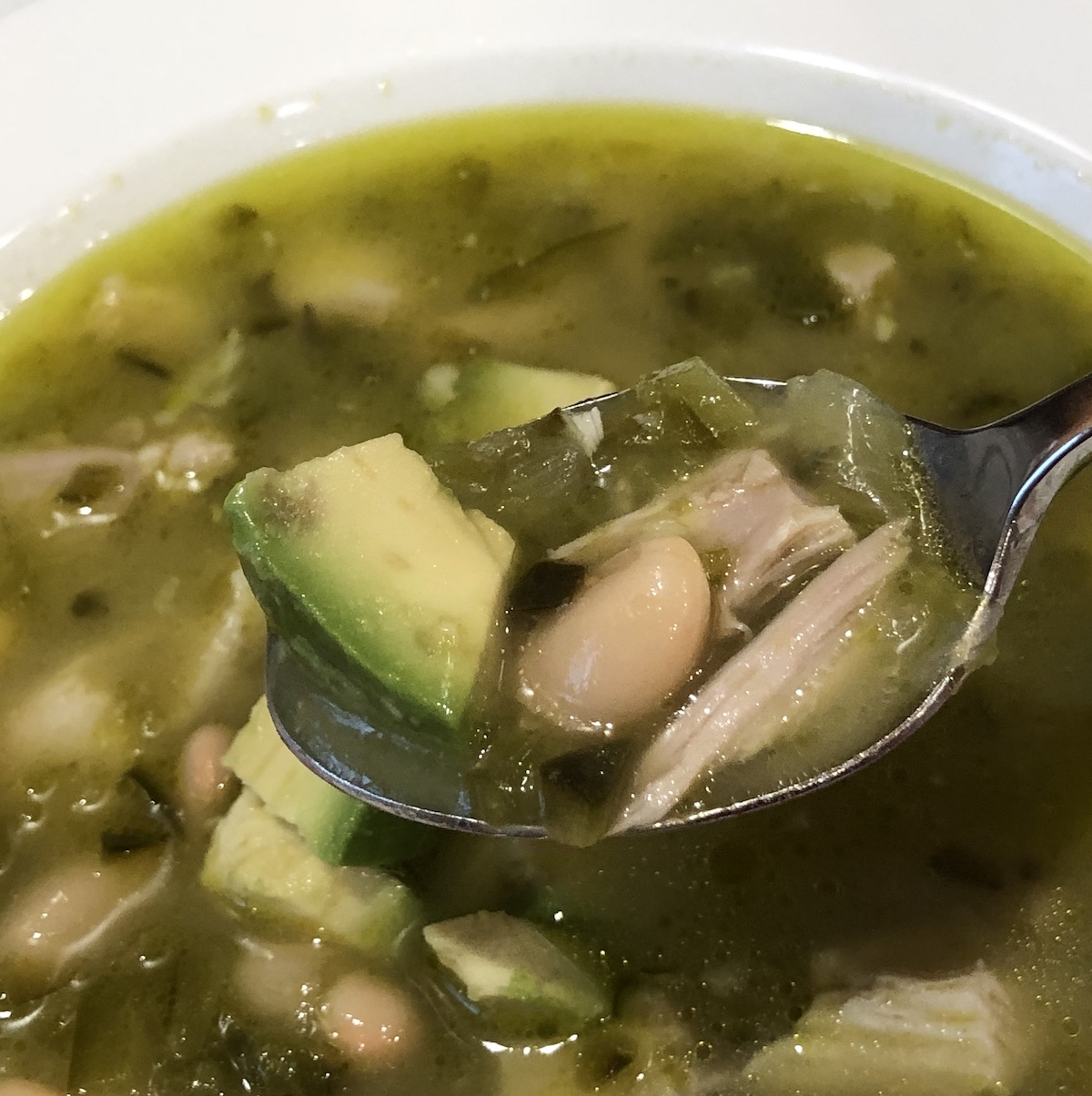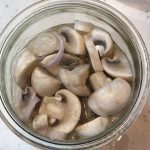
The Cooking Framework Quiz is available by clicking the button below.
Don’t miss an episode!
The button below will take you to Apple Podcasts to subscribe.
Or visit your favorite podcast provider to subscribe.
Thank you!
Transcript
Welcome to The Sensitive Kitchen. Where home cooks are inspired to Cook to Enable Those You Love to Flourish.
I’m Cindy Sullivan, registered dietitian, passionate nutrition educator, and accomplished home cook. Whether you’re changing how you cook for food sensitivities, allergies, intolerances, or just trying to eat healthier on a budget, you’re in the right place. Most episodes, I will share favorite recipes as well as modification tips, and nutrition benefits. Occasionally I’ll have a guest or special episode like modifying holiday favorites.
My favorite foods? They’re raspberries and homemade chocolate chip cookies. My latest cooking project was long fermented sourdough bread.
Green chicken chili. What in the world is green chicken chili? It’s what most people call white chicken chili.
But mine is so green that we’ve named it green chicken chili. Cinco de Mayo is tomorrow. It usually triggers a sale on avocados. My avocado recipes come out to play
Besides the Mandarin avocado salad, which is episode 014 that we’ll have next week when my son comes home from college, I made green chicken chili yesterday. Avocados are an essential garnish for me, but you can skip them if you don’t like them, or if they’re too expensive.
This is an easy recipe for allergies. There are very few except in the garnishes, which are easy to change. Now, as I mentioned, I mostly followed the white chicken chili recipe in the book, The Best Make Ahead Recipe by Cook’s illustrated and I’ll link to it in the show notes.
But why they call it white chicken chili as anyone’s guess. It’s most certainly green. I’ve been making it for at least six years and it is always green. This is a tasty chili that I would make every month. If it were not so much work.Tthose of you who follow me, know that I usually bring you simple or easy recipes, not this one, at least if you want milder chili.
But it’s lighter than regular chili. I usually think of regular chili’s being fall or winter. This one I could eat year round. And it’s wonderful for the spring. This recipe uses fresh chilies: poblanos, anaheims, and jalapenos. If you are not a fan of spicy food, don’t give up yet. You’re going to remove both the seeds and the ribs from the peppers. You’ll have wonderful flavor with virtually no spice.
The problem is is that removing all those ribs from about 12 peppers is time-consuming. So is taking the chicken off the bone and chopping it up after it cooks. So when I make this recipe, what I’m giving you is a very large amount. Why? Because I only want to make it a couple times a year.
I actually want to make it more, but I only realistically make it a couple times a year. And this way I can freeze several batches so that I have it on hand to eat other days. If I didn’t like this recipe so much, I would never do it, but I think it’s that good. So a couple times a year I brave the peppers and the chicken.
Let me list the ingredients for you. Remember that the entire recipe with pictures and amounts is found on foosensitivitykitchen.com/episode027. So you’re going to use fresh peppers, onions, or shallots, garlic, some ground cumin, chicken and chicken broth, great Northern beans or any canned white beans, lime juice. And then whatever you want for garnishes,
Let’s start with the peppers. It uses three kinds of milder peppers, poblanos, anaheims, and jalapenos. I have been known to vary the number of pepper slightly from what the recipe calls for. If they only have three poblanos that looked good. I might up the number of anaheims or vice versa. Okay. If you like spicier food, you can save yourself a lot of time by just removing the seeds and not the ribs.
That’s one of the most time-consuming things in this recipe, but all of them are fairly mild peppers, as I mentioned. So it won’t be extremely spicy. Even with the ribs.
For chicken, I use thighs. The original recipe calls for breasts. I thought, “Oh, this time I’ll make it with breasts.” Well I got to the store and thighs were significantly cheaper, so that’s what I used.
I often have chicken meat left over after I’ve cooked it and I take it out of the pan and I chop it up. It would be overwhelming with how much chicken sometimes I get. So I save some and I freeze it and I use it in chicken tacos or burritos or burrito bowls.
Use the chicken with the bones and it will make the broth richer and more flavorful. However, it will take you a little more time to chop the chicken. So if time is more important here, I might use a boneless.
Let’s talk about chicken broth. This is the one place where you don’t have to use your best chicken breath. The one that turned out a little weak, it’s fine. So as store-bought, if there’s a brand, you can use.
White beans. As I mentioned, I use great northern, but any canned white beans, will do. Be aware if you use cannellini beans, they will tend to break up more and turn a little mushier.
I mentioned onions or shallots and garlic, ground cumin and lime juice.
Now for garnishes: chopped avocados are essential for me. However, if they’re expensive or you don’t like them, use whatever garnishes you want. Chopped scallions, minced jalapenos, chopped, fresh oregano sour cream, chopped cilantro, et cetera, et cetera, et cetera. We were eating at the other night, his second bowl, my husband crumpled some tortilla chips on the top.
Now there are a couple pieces of equipment that are absolutely essential to make this recipe.
And the first one is rubber gloves. I have chopped many peppers, hot peppers, without rubber gloves, but the times I have made this recipe without rubber gloves, I have regretted it. The sheer volume of hot peppers in this recipe, you need the rubber gloves. The volume of peppers made my hands a burning mess. Soap would not remove the residue.
If you find yourself in this boat, what helped me the most was rubbing cooking oil all over my hands and then using soap and rubbing it well into my hands. And then using soap and water, the cooking oil again, and then soap and water again. I don’t want you to experience that pain. Use rubber gloves.
Now I did not use fancy rubber gloves. I used awkward food service gloves, and I ended up needing two pairs, but they saved my hands. Use the gloves.
The second equipment that you really do need for this recipe is a food processor. You probably could get by with a blender if you don’t mind doing a lot of chopping. You’re going to use a food processor for two things.
You’re going to chop the peppers and onions coarsely, and then let the food processor do the heavy chopping and to like a salsa consistency. And then you’re going to puree a cup of beans and chicken broth and sauteed peppers to thicken the chili, a cup each of them.
So let’s talk a little bit about the how to,. To prepare the peppers -remember there are pictures on the website, foodsensitivitykitchen.com/episode027.
There are many methods for preparing peppers and in case it helps. I’ll give you mine. Put on your gloves. Don’t skip this step. You’ve already washed your peppers. Then put on your gloves. Cut off the end of the pepper that has the stem on it. With your knife, go around the core. It’s usually attached at two or more points at the top. And then cut the pepper in half about it the middle. Most of the seeds in the core are going to be in the top half. Slice the top half, top to bottom and remove the core and the seeds. and slice the bottom in half. Often I like to put the bottom standing up like a little pyramid on my cutting board and slice it right in half.
Now the hard part is removing the ribs. – they’re the white part that stick out into the pepper, the inside of the pepper that run from top to bottom in the pepper. You might find it easier to slice the pepper right next to the rib, and then cut it off. You can just remove the white part. The colored part underneath the white part will not be hot. It’s easier to do this on the poblano and the Anaheim peppers.
Save the jalapenos for last. You’ll have lots of practice on the other two. By the time you get to the jalapenos. Put on your favorite podcast or music and cut away.
You can prepare the peppers a day or two ahead, store them in a plastic bag in the refrigerator. Do not store them in a plastic container. If you don’t use a disposable bag, store them in glass.
When you’re ready to make the chili, roughly chop your peppers and onions. Put them in two or three batches in your food processor and pulse it anywhere 10 to 15 times until they’re coarsely chopped about the consistency of salsa. Put about a tablespoon of oil in an eight to 12 quart pot. You need a big pot. You’re going to make a lot of chili.
I prefer to use my 12 quart soup pot. Add the processed peppers and the onion and saute over medium heat stirring occasionally. As soon as you begin to saute the peppers, use a garlic press or mince the garlic and place that into the pot. Cook until the peppers, onions and garlic are softened about 10 to 15 minutes over medium heat. Add the cumin the last five minutes or so.
Remove – when they’re softened – remove about one cup of the chilis mixture and process it with one cup of beans and one cup of chicken broth and process it until it’s relatively smooth.
Place it in the pot, add the chicken and the chicken broth and bring to a boil covered. And cook, partially covered, cook about 20 minutes, partially covered.
Remove the chicken from the pot and add the beans. While the beans warm up, chop the chicken discarding the skin.
Now, if you’re making this ahead, after you remove the chicken from the pot, add the beans and cool the pot in a sink full of cold water. Place the chicken, covered, in the refrigerator. And I find the chicken is much easier to chop when it’s cold. So it will save you some time and some burned fingers if you make this ahead.
Now, when I chopped my chicken, I always seem to have more chicken than I want to add back to this chili. And that’s okay with me because it makes great tacos or burrito bowls or burritos or fajitas. I just freeze it until I’m ready to use the chicken.
Add the chicken to the pot and warm it up. Just before serving, add the lime juice and serve with yummy garnishes. Enjoy!
For our nutrition tidbit today. Let’s talk about these fresh peppers that we’re using. The ones we’re using are fairly mild peppers.
Let’s start with the poblanos. It’s a darker green pepper, about six inches long and a couple inches around. It’s a little milder than a jalapeno, about 2000 onthe Scofield scale. It has a mild, slightly sweet flavor, but it’s hotter if they let it ripen until they’re red. The dried red ones are called ancho chili peppers, and they’re used in mole and enchiladas. I used to use ancho chili powder in place of regular chili powder when we were avoiding garlic and onions, because a lot of commercial chili powder has those ingredients. So I would use dried ancho chili powder.
Now poblanos are rich in vitamin C – more than a hundred percent of the RDA for vitamin C for a cup of poblanos, about 30% of the vitamin A and they contain other carotinoids as well, which are antioxidants in your body. A cup of poblanos provides two milligrams of iron, which is actually quite a lot for a pepper. And it’s all for 25 calories.
Now, while we are talking about hot peppers, we need to talk about capsaicin. All chili peppers, including green chilies contain capsaicin, the compound, that’s responsible for the spicy sensation associated with eating a hot pepper. The spicy or the pepper. It is the more capsaicin it contains and the Scoville heat unit in at scale, which measures capsaicin content goes from zero to 15 million. It places these green chilies we’re using between about 500-2,500 Units.
The American Institute for Cancer Research reports that eating capsaicin rich sources like green chili peppers may inhibit the growth of cancer cells, although they say more research of course is needed.
Capsaicin may help fight inflammation, reduce cancer risk, except for stomach cancer, help with immune function and may help fight auto-immune disease. So that’s some reason to eat some of these green chili peppers or hotter, if you prefer.
Let’s talk a little bit about anaheim chilies: Anaheim chilies have a mild sweet flavor.
In about half a cup of them, you get 219% of the vitamin C you need in a day, that’s huge, 111% of the vitamin A in the form of carotinoids, 16% of the B6 and 10% of the vitamin K.
Now anaheim chiles range in how hot they are from about 500 to 2,500 Scofield unit scale. There was an article I read in Bon Appetite about anaheim chilies. And I loved what they said. The author said this mild pepper adds major flavor without melting your face off.
When We talk about these green chilies, they’re the immature chili peppers, the Anaheim and the poblanos fall in this category. They’ve been harvested before fully ripened. So they’re not as spicy as the red chili peppers and they’re available raw, which is what this recipe uses, canned, pickled. And they’re common addition to the traditional Hispanic dishes ranging from soups to snacks.
Green chilies are low in calories, virtually fat-free and rich in nutrients that can enhance your health. We’ve already mentioned vitamin A, vitamin C, a little bit of vitamin K and capsaicin. However, if you have a chronic digestive disorder like irritable bowel syndrome or heartburn, spicy foods, like chilis may exacerbate your symptoms. So you need to be careful. Now I will say that people in my family, when I make this green chicken chili recipe, and I remove all the seeds and the ribs have had no trouble at all with it, but obviously your mileage may vary.
Let’s talk about the last one of these peppers, which is actually the spiciest, which is jalapenos. Okay. Now what I did not realize, I guess I knew, but I never really paid attention because they always have, in my grocery store, the same jalapenos, but there are four really common types of jalapenos and how spicy they are depends not only on how ripe they are, but what variety.
They are an interesting study about jalapenos. Oh,and I already mentioned that these are harder to get all the ribs out. It takes a little bit more work. I usually slice off the top and then just slice them in half because they’re so small compared to the Anaheim’s in the public knows.
Okay. But one Study showed that people who ate hot pepper several times a week were 13%. Let’s say likely to die during this 19 year study than those who ate few to no peppers. And the researchers believe it’s the capsaicins rural and promoting blood flow and preventing obesity that may contribute. As I mentioned, some research shows that capsaicin may make heartburn worse and cause problems for people with irritable bowel syndrome. So you want to avoid, if you have a digestive system condition and you may want to avoid the other ones as well. There is some evidence that if you soak cut up jalapenos and salt water for at least half an hour before you eat them or cook them, it lowers some of the spiciness.
Now I haven’t had any trouble removing the seeds and, and the ribs because they are much less spicy that way. One jalapeno gives you the RDA for vitamin C. It’s a good source of vitamin A, potassium, iron. And it has smaller amounts of magnesium phosphorus, zinc, copper, and manganese.
So what’s the bottom line? Jalapenos, poblanos, anaheims are versatile. They’re nutritious, and you can enjoy them in a variety of ways. They contain capsaicin the compound, that likely accounts for their many health benefits, including perhaps weight loss, pain relief, improved heart health, lower ulcer risk, and they’re safe for most people. But they can produce a temporary burning sensation in your mouth and uncomfortable intestinal side effects.in some people, especially if you have intestinal underlying disease or inflammation.
If you enjoy spicy food, you don’t experience the side effects, jalapenos can be a healthy addition to your diet. So can poblanos and anaheims. And if you don’t like spicy food, just take a few extra minutes, take out the ribs and enjoy this wonderful green chicken chili with amazing flavor you can customize.
It’s naturally gluten free, dairy free, no nuts, no seafood, no soy. It’s an allergy free easy meal that everybody in my family adores. Enjoy.
Keep Cooking to Enable Those You Love to Flourish. Have a wonderful week. Talk to you next Tuesday. Bye-bye.
References
https://www.webmd.com/food-recipes/health-benefits-jalapenosBY
Health Benefits of Jalapeños – WebMD
Medically Reviewed by Kathleen M. Zelman, MPH, RD, LD on July 31, 2019
https://www.healthline.com/nutrition/jalapeno-health-benefits#bottom-line
7 Surprising Health Benefits of Jalapeños
Written by Erica Julson, MS, RDN, CLT — Updated on March 10, 2018
ALEX DELANY
https://www.bonappetit.com/story/anaheim-chile-peppers
Why You Should Really Be Cooking with Anaheim Peppers
https://www.nutrition-and-you.com/jalapeno-peppers.html
Jalapeno peppers nutrition facts
Jalapeno Health Benefits: from Pain Relief to Weight Loss
https://www.pepperscale.com/jalapeno-health-benefits/
https://healthyeating.sfgate.com/green-chili-health-benefits-7389.html
Green Chili Health Benefits. By Updated November 21, 2018
Anaheim Pepper Nutrition: How Healthy Are They?
https://www.pepperscale.com/anaheim-pepper-nutrition/
Poblano Pepper Nutrition: How Healthy Are They?
https://www.pepperscale.com/poblano-pepper-nutrition/
What Are Poblano Peppers? Nutrition, Benefits, and Uses Written by Lizzie Streit, MS, RDN, LD on January 15, 2020 — Medically reviewed by Miho Hatanaka, RDN, L.D.
https://www.healthline.com/nutrition/what-are-poblano-peppers
Ultimate Guide to Growing Jalapenos May 30, 2021 by HappyDIYHome Staff
https://happydiyhome.com/growing-jalapenos/




